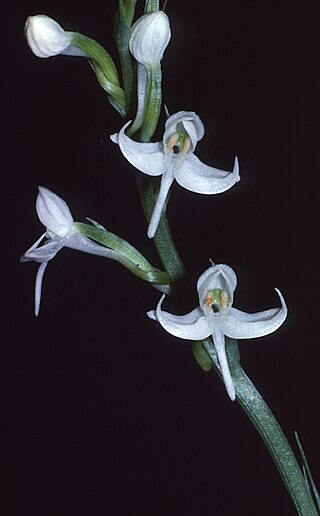
Octomeria is a plant genus belonging to the family Orchidaceae. The genus comprises about 150 species native to the Neotropics, mostly in Brazil.
Benthamia is a genus of orchids. It contains 29 recognized species, all native to Madagascar, Mauritius and Réunion.

Ceratostylis is a genus of orchids with more than 140 species distributed in China, India, Southeast Asia, New Guinea, the Philippines, and Melanesia.

Campylocentrum is a genus of rare orchids native to Mexico, the West Indies, Central America and South America. One species (C. pachyrrhizum) extends its range into Florida.

Epidendrum secundum, one of the crucifix orchids, is a poorly understood reed stemmed species, which Dressler (1989) describes as "the Epidendrum secundum complex." According to Dressler, there are dozens of varieties, some of which appear to deserve species rank. Arditti and Ghani note that E. secundum has the distinction of bearing the longest seeds known in the Orchidaceae, 6.0 mm long. By comparison, the seeds of E. ibaguense are only 2.9 mm long.
Ciceronia is a genus of flowering plants in the family Asteraceae.
Harnackia is a genus of flowering plants in the family Asteraceae. It contains only one species, Harnackia bisecta, which is endemic to Cuba.
Bulbophyllum abbreviatum is a species of orchid in the genus Bulbophyllum discovered in Madagascar and originally described by German botanist Rudolf Schlechter, from material collected by French botanist H. Perrier de la Bâthie in February 1912, which is now kept in the Muséum National d'Histoire Naturelle in Paris.
Dactylosporina is a genus of fungi in the family Physalacriaceae. D. brunneomarginata, the first representative of the genus found in Asia, was added to Dactylosporina in 2015.
Feddea is a genus of flowering plants in the family Asteraceae.
Schischkinia is a genus of Asian flowering plants in the family Asteraceae.
Callicarpa elegans is a plant species in the genus Callicarpa found in the Philippines.
Haenianthus is a genus of plants native to the Greater Antilles of the Caribbean. It contains 3 species:
- Haenianthus incrassatus(Sw.) Griseb. - Jamaica
- Haenianthus salicifoliusGriseb. - Cuba, Hispaniola, Puerto Rico
- Haenianthus variifoliusUrb. - Cuba

Stipa zalesskii is a grass found in Europe and Asia. It is an important grass in Eurasian steppe. Its culms are 30–75 cm long and the leaf-blades 20–35 cm long by 0.6–1 mm wide.
Iris leptophylla is a plant species in the genus Iris, it is also in the subgenus Iris and in the section Pseudoregelia. It is a rhizomatous perennial, from China. It has thin, long grey-green leaves, long slender stem and 2 fragrant purple, blue-purple, violet or lavender pink flowers. It is cultivated as an ornamental plant in temperate regions.
Quercus coffeicolor is a species of oak. It is native to Nayarit, Sinaloa, and Jalisco in western Mexico.

Habenaria ferdinandi, commonly known as the yellow rein orchid, is a species of orchid that is endemic to the Northern Territory. It usually has two leaves at its base and up to fifteen tiny yellowish green, strongly scented flowers.
Sofya Georgiyevna Tamamshyan (1901–1981) was a Russian-Soviet botanist and plant taxonomist noted for describing 7 genera and more than 50 species, and for authoring over 120 works. The standard author abbreviation Tamamsch. is used to indicate this person as the author when citing a botanical name.
Quercus acutangula is a species of oak native to Guerrero, Mexico. It usually grows in either the desert or the dry shrubland biome. It was first published in Repert. Spec. Nov. Regni Veg. 33: 318 in 1934 by William Trelease.

Peperomia unduavina is a species of plant from the genus Peperomia. It was first described by Casimir de Candolle and published in the book "Repertorium Specierum Novarum Regni Vegetabilis 13: 306. 1914.". It primarily grows on wet tropical biomes It is named after Unduavi, the place where the species were discovered.







